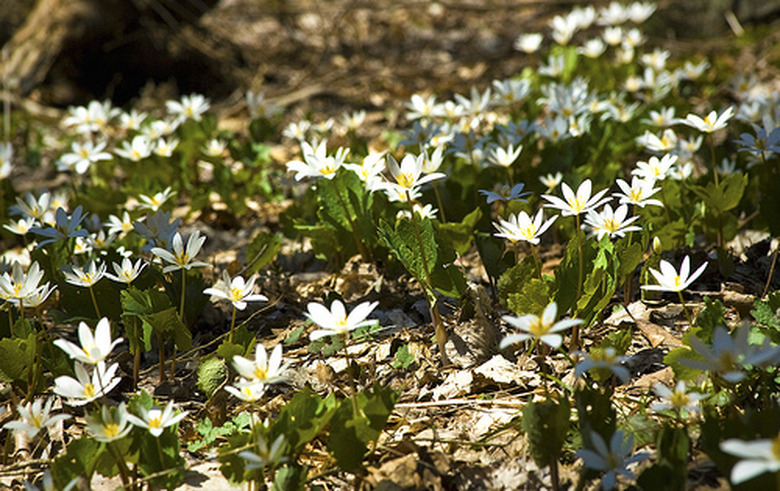How To Grow Bloodroot
Things Needed
- Organic compost
- Garden tiller
- Bark mulch
- Flower fertilizer
Tip
Bloodroot may be planted from container plants found at nurseries and home and garden stores in early spring. Space the plants at least 2 to 4 inches apart. Allow bloodroot plants to self-sow, as the seeds are difficult to germinate indoors.
Warning
Make sure bloodroot plants have not been harvested from the wild prior to purchasing, as their native populations are threatened.
Bloodroot is a perennial wildflower that's native to the eastern woodlands of North America. Its name is derived from the thick, red sap that leaks from the rhizome when cut. Bloodroot plants may only reach 9 inches in height, but each plant can spread up to 12 inches. The plants form large colonies over time, if allowed to self-sow. Blue-green colored foliage is attractive in early spring through summer, and white flowers are born in early spring.
Step 1
Choose a planting location that receives filtered sun in spring and partial-to-full shade in the summer. Prepare the area by spreading a 1-to-2 inch layer of organic compost over the site. Use a garden tiller to incorporate the compost into the soil. Bloodroot needs rich, well-drained soil that's high in organic matter.
- Bloodroot is a perennial wildflower that's native to the eastern woodlands of North America.
- The plants form large colonies over time, if allowed to self-sow.
Step 2
Plant dormant bloodroot rhizomes in early spring or early fall. Dig a hole slightly wider than the rhizome and about 4 inches deep, place it gently into the hole so it is lying horizontally and gently cover with soil. Make sure the rhizome is resting just below the soil line, and avoid planting it too deep so new shoots can form.
Step 3
Spread a 1-to-2 inch layer of bark mulch around the base of bloodroot plants once they have become established to emulate the leaf litter they would normally have in the wild. Use cedar or pine bark mulch for the best results.
Step 4
Keep the soil moist all year to prevent bloodroot from going into dormancy early. If watered regularly, the leaves will remain through most of the summer months. Water once per week in fall and winter, and increase to twice per week during the growing season.
- Plant dormant bloodroot rhizomes in early spring or early fall.
- Spread a 1-to-2 inch layer of bark mulch around the base of bloodroot plants once they have become established to emulate the leaf litter they would normally have in the wild.
Step 5
Feed bloodroot plants once per year in spring, beginning in the second year of growth. Use a balanced flower fertilizer to encourage more prolific blooming. Refer to the manufacturer's instructions for proper dosage and application.
References
- Cornell University Flower Growing Guides: Bloodroot
- Making the Most of Shade: How To Plan, Plant and Grow a Fabulous Garden That Lightens up the Shadows; Larry Hodgson; 2005
- The Garden Primer; Barbara Damrosch; 2003
